2: Approaches to Music Education
- Last updated
- Save as PDF
- Page ID
- 86328

- Natalie Sarrazin
- The College at Brockport via OpenSUNY
\( \newcommand{\vecs}[1]{\overset { \scriptstyle \rightharpoonup} {\mathbf{#1}} } \)
\( \newcommand{\vecd}[1]{\overset{-\!-\!\rightharpoonup}{\vphantom{a}\smash {#1}}} \)
\( \newcommand{\dsum}{\displaystyle\sum\limits} \)
\( \newcommand{\dint}{\displaystyle\int\limits} \)
\( \newcommand{\dlim}{\displaystyle\lim\limits} \)
\( \newcommand{\id}{\mathrm{id}}\) \( \newcommand{\Span}{\mathrm{span}}\)
( \newcommand{\kernel}{\mathrm{null}\,}\) \( \newcommand{\range}{\mathrm{range}\,}\)
\( \newcommand{\RealPart}{\mathrm{Re}}\) \( \newcommand{\ImaginaryPart}{\mathrm{Im}}\)
\( \newcommand{\Argument}{\mathrm{Arg}}\) \( \newcommand{\norm}[1]{\| #1 \|}\)
\( \newcommand{\inner}[2]{\langle #1, #2 \rangle}\)
\( \newcommand{\Span}{\mathrm{span}}\)
\( \newcommand{\id}{\mathrm{id}}\)
\( \newcommand{\Span}{\mathrm{span}}\)
\( \newcommand{\kernel}{\mathrm{null}\,}\)
\( \newcommand{\range}{\mathrm{range}\,}\)
\( \newcommand{\RealPart}{\mathrm{Re}}\)
\( \newcommand{\ImaginaryPart}{\mathrm{Im}}\)
\( \newcommand{\Argument}{\mathrm{Arg}}\)
\( \newcommand{\norm}[1]{\| #1 \|}\)
\( \newcommand{\inner}[2]{\langle #1, #2 \rangle}\)
\( \newcommand{\Span}{\mathrm{span}}\) \( \newcommand{\AA}{\unicode[.8,0]{x212B}}\)
\( \newcommand{\vectorA}[1]{\vec{#1}} % arrow\)
\( \newcommand{\vectorAt}[1]{\vec{\text{#1}}} % arrow\)
\( \newcommand{\vectorB}[1]{\overset { \scriptstyle \rightharpoonup} {\mathbf{#1}} } \)
\( \newcommand{\vectorC}[1]{\textbf{#1}} \)
\( \newcommand{\vectorD}[1]{\overrightarrow{#1}} \)
\( \newcommand{\vectorDt}[1]{\overrightarrow{\text{#1}}} \)
\( \newcommand{\vectE}[1]{\overset{-\!-\!\rightharpoonup}{\vphantom{a}\smash{\mathbf {#1}}}} \)
\( \newcommand{\vecs}[1]{\overset { \scriptstyle \rightharpoonup} {\mathbf{#1}} } \)
\( \newcommand{\vecd}[1]{\overset{-\!-\!\rightharpoonup}{\vphantom{a}\smash {#1}}} \)
\(\newcommand{\avec}{\mathbf a}\) \(\newcommand{\bvec}{\mathbf b}\) \(\newcommand{\cvec}{\mathbf c}\) \(\newcommand{\dvec}{\mathbf d}\) \(\newcommand{\dtil}{\widetilde{\mathbf d}}\) \(\newcommand{\evec}{\mathbf e}\) \(\newcommand{\fvec}{\mathbf f}\) \(\newcommand{\nvec}{\mathbf n}\) \(\newcommand{\pvec}{\mathbf p}\) \(\newcommand{\qvec}{\mathbf q}\) \(\newcommand{\svec}{\mathbf s}\) \(\newcommand{\tvec}{\mathbf t}\) \(\newcommand{\uvec}{\mathbf u}\) \(\newcommand{\vvec}{\mathbf v}\) \(\newcommand{\wvec}{\mathbf w}\) \(\newcommand{\xvec}{\mathbf x}\) \(\newcommand{\yvec}{\mathbf y}\) \(\newcommand{\zvec}{\mathbf z}\) \(\newcommand{\rvec}{\mathbf r}\) \(\newcommand{\mvec}{\mathbf m}\) \(\newcommand{\zerovec}{\mathbf 0}\) \(\newcommand{\onevec}{\mathbf 1}\) \(\newcommand{\real}{\mathbb R}\) \(\newcommand{\twovec}[2]{\left[\begin{array}{r}#1 \\ #2 \end{array}\right]}\) \(\newcommand{\ctwovec}[2]{\left[\begin{array}{c}#1 \\ #2 \end{array}\right]}\) \(\newcommand{\threevec}[3]{\left[\begin{array}{r}#1 \\ #2 \\ #3 \end{array}\right]}\) \(\newcommand{\cthreevec}[3]{\left[\begin{array}{c}#1 \\ #2 \\ #3 \end{array}\right]}\) \(\newcommand{\fourvec}[4]{\left[\begin{array}{r}#1 \\ #2 \\ #3 \\ #4 \end{array}\right]}\) \(\newcommand{\cfourvec}[4]{\left[\begin{array}{c}#1 \\ #2 \\ #3 \\ #4 \end{array}\right]}\) \(\newcommand{\fivevec}[5]{\left[\begin{array}{r}#1 \\ #2 \\ #3 \\ #4 \\ #5 \\ \end{array}\right]}\) \(\newcommand{\cfivevec}[5]{\left[\begin{array}{c}#1 \\ #2 \\ #3 \\ #4 \\ #5 \\ \end{array}\right]}\) \(\newcommand{\mattwo}[4]{\left[\begin{array}{rr}#1 \amp #2 \\ #3 \amp #4 \\ \end{array}\right]}\) \(\newcommand{\laspan}[1]{\text{Span}\{#1\}}\) \(\newcommand{\bcal}{\cal B}\) \(\newcommand{\ccal}{\cal C}\) \(\newcommand{\scal}{\cal S}\) \(\newcommand{\wcal}{\cal W}\) \(\newcommand{\ecal}{\cal E}\) \(\newcommand{\coords}[2]{\left\{#1\right\}_{#2}}\) \(\newcommand{\gray}[1]{\color{gray}{#1}}\) \(\newcommand{\lgray}[1]{\color{lightgray}{#1}}\) \(\newcommand{\rank}{\operatorname{rank}}\) \(\newcommand{\row}{\text{Row}}\) \(\newcommand{\col}{\text{Col}}\) \(\renewcommand{\row}{\text{Row}}\) \(\newcommand{\nul}{\text{Nul}}\) \(\newcommand{\var}{\text{Var}}\) \(\newcommand{\corr}{\text{corr}}\) \(\newcommand{\len}[1]{\left|#1\right|}\) \(\newcommand{\bbar}{\overline{\bvec}}\) \(\newcommand{\bhat}{\widehat{\bvec}}\) \(\newcommand{\bperp}{\bvec^\perp}\) \(\newcommand{\xhat}{\widehat{\xvec}}\) \(\newcommand{\vhat}{\widehat{\vvec}}\) \(\newcommand{\uhat}{\widehat{\uvec}}\) \(\newcommand{\what}{\widehat{\wvec}}\) \(\newcommand{\Sighat}{\widehat{\Sigma}}\) \(\newcommand{\lt}{<}\) \(\newcommand{\gt}{>}\) \(\newcommand{\amp}{&}\) \(\definecolor{fillinmathshade}{gray}{0.9}\)Chapter Summary: The goal of this chapter is to introduce the reader to the most well-known music teaching methods used in music education. They are Zoltan Kodály, Emile-Jacques Dalcroze, Orff Schulwerk, Edwin Gordon, Shinseki Suzuki, and Reggio Emilia. This chapter also familiarizes the reader with each method’s philosophy and principles, unique pedagogy, and practices and activities.
The material introduced in this chapter will be referenced and built upon throughout the remainder of the book.
Music Methods for Working With Children
What Is a Method?
A music education, or any other type of education method, is a teaching approach that has: 1) an identifiable underlying philosophy or set of principles; 2) a unified body of pedagogy unique to it with a body of well-defined practice; 3) goals and objectives worthy of pursuit; and 4) integrity (i.e., its reason for existence must not be commercial) (Chosky et al.).
Although these approaches are often taught in music education classes, they are highly applicable, accessible, and integrated methods appropriate for anyone interested in working with children and the arts, or music in education in addition to music education. All educators can incorporate the basic techniques used in these methods as they offer creative, arts-driven curricula through which to teach.
Method Similarities
The music methods of Jaques-Emile Dalcroze, Zoltan Kodály, Carl Orff, and S. Suzuki are time-tested and contain well-practiced and researched techniques for teaching music. All of these approaches to music learning contain fundamental similarities in that they:
- Are systematic and sequential in design;
- Utilize music with authenticity and integrity, such as folk music;
- Are based on incorporating the “mother-tongue” approach to rhythm, pitch, and timbre from the child’s persepctive, innate behaviors and how interaction with their natural environment; and
- Encourage active engagement with the student.
They are also “comprehensive and holistic [in preparing] children to be artists, creators, and producers and not just consumers of music.They pair active and actual music-making with conceptual learning experiences offered in a systematic approach” (Moore).
The holistic nature of these highly integrated approaches, is still conducive today for implementation in an integrated arts program. This is due to the fact that their core identities, particularly Orff and Dalcroze, contain elements of drama, movement, sound, and music.
Orff Schulwerk
Philosophy
Since the beginning of time, children have not liked to study. They would much rather play, and if you have their interests at heart, you will let them learn while they play; they will find that what they have mastered is child’s play.
—Carl Orff
The Orff Schulwerk method is the only approach that is not a systematic “method” per se, although it does entail fostering creative thinking through improvisational experiences. Rather than a system, Schulwerk combines instruments, singing, movement, and speech to develop children’s innate musical abilities. There are four stages of teaching:
- Imitation
- Exploration
- Improvisation
- Composition
Schulwerk is rooted in arts and subject integration. In the early 20th century, Carl Orff met gymnastics and dance educator Dorothée Gunther and established an innovative school for children based on the idea that all human beings are musical by nature. Their approach was to combine movement (gymnastics), music, and dance. Orff developed the concept of elemental music based on the synthesis of the arts of the Greek Muses, which combined tone, dance, poetry, image, design, and theatrical gesture. Gunther and Orff’s approach was to create a comfortable environment that approximates the child’s natural world of play, thus allowing children to be introduced to a range of musical skills in a relaxed and stress-free setting.
Carl Orff’s definition of elemental music is based on small-scale musical patterns (e.g., ostinato, drone) familiar to the students.
What then is elemental music? Elemental music is never music alone but forms a unity with movement, dance and speech. It is music that one makes oneself, in which one takes part not as a listener, but as a participant. It is unsophisticated, employs no big forms and no big architectural structures, and it uses small sequence forms, ostinato and rondo. Elemental music is near the earth, natural, physical, within the range of everyone to learn it and experience it and suitable for the child… (1963)
Orff Schulwerk utilizes children’s natural behaviors of play—experimenting, improvising—to access children’s innate musicality. Schulwerk uses the native language, sounds, timbres, rhythms, melodies, and tonal material surrounding the child, particularly in its folk music repertoire. Similar to many of the other methods, the Orff Schulwerk emphasizes that children should experience first and then analyze or intellectualize about music afterwards, and encourages hands-on music-making regardless of skill level.
The Orff Instrumentarium
In early 20th century Germany, there were few instruments accessible to children. Orff began by buying recorders, which were rare at the time. Since no one knew how to play them, Dorothée Gunther created instructional books to teach recorder to children. No one knew how to play them, so Dorothée Gunther created instructional books to teach them. Carl Orff came across an African xylophone, and developed a way to transform the xylophone into an instrument for the children at the school to play. He then developed the metal-barred metallophones from the idea of the Indonesian gamelan orchestra and the German glockenspiels, which were small metal-plated instruments found in Germany. Thus the instrumentarium was born—the complete set of which includes bass bars, bass, alto/tenor, and soprano metallophones, xylophones and alto and soprano glockenspiels. While each instrument is limited in range to fewer than two octaves, all together, from bass bars to soprano glockenspiel, the ensemble covers six octaves, creating an entire orchestra!
Soprano Glockenspiel Range (C7–A9)

Soprano Xylophone–Soprano Metallophone–Alto Glockenspiel Range (C5–A7)

Alto Xylophone–Alto Metallophone Range (C4 [Middle C]–A6)

Bass Xylophone–Bass Metallophone (C3–A5)

Contra Bass Bar Range (C2–C3)


“Instrumentarium Orff-Schulwerk” By Société Studio 49 CC BY-SA 4.0
The Orff Instrumentarium
Patterned accompaniments
Orff believed that one of the easiest ways to encourage student participation in music while also contributing to beautiful music-making is to have them play a simple accompaniment on a xylophone. By second grade, most students will be able to keep a steady beat, with a fair number able to do so by first grade. Below are some basic accompaniment patterns on the xylophone or metallophone that students should be able to perform easily.
Bordun/Chord Bordun: An open 5th, containing the 1st and 5th degrees of the chord. The 3rd is not played. For example, a bordun in C will include the two pitches C and G; in F, the F and C; in G the G and D; in d minor the d and a, etc. A chord bordun means that the 1st and 5th degrees are played simultaneously.




Example of Bass Bordun With Introduction and Simple Pentatonic Melody

Broken Bordun: The notes of the bordun are played separately.


Moving/Broken Chord Bordun

Example of Moving Chord Bordun With “Lil’ Liza Jane” Melody

Level Bordun: The bordun plays in different octaves.

Crossover Bordun: The mallets cross over to play the pattern.

Drone: A note or chord continuously sounding without change. A bordun functions as a type of drone.

Ostinato: Motif or phrase that repeats.

Orff as arts integration
One of Orff Schulwerk’s major contributions is its emphasis on arts integration. Orff includes language (stories, poetry, rhythmic speech), movement (dance, improvisation), and drama as well as music.
The Orff process
The American adaptation of Orff Schulwerk utilizes four stages to organize the process of teaching music: imitation, exploration, improvisation, and composition. These four stages establish the fundamental building blocks for children to develop musical literacy. They are similar to Bloom’s taxonomy, in that they begin by introducing a very basic skill set and then gradually move on to more complex activities such as composition, which is represented in the upper phases of the taxonomy.
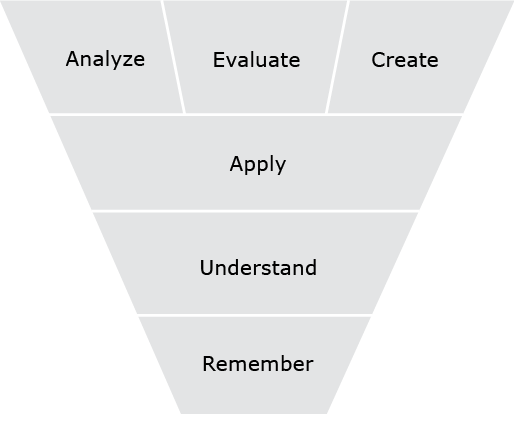
Source: Bloom’s Cognitive Domain by user:Nesbit, PD.
Bloom’s Taxonomy
Parallels between Orff’s building blocks and Bloom’s taxonomy
Orff’s Building Blocks |
Bloom’s Taxonomy |
|
Imitation Exploration Improvisation Composition |
Remember Understand Apply Create, Analyze |
Imitation: Echoing, responding
Imitation builds the student’s repertoire of pitches, rhythms, meter, tempo, and dynamics. Students absorb the fundamental music materials for their “tool box” to be used in more complex activities in the future.
Exploration
Students begin to understand and even apply the knowledge learned through imitation. They hear the movement of pitches, the content of rhythms, the movement of meter, and explore the timbre of whatever instrument or voice with which they have access. The Orff Instrumentarium provides almost limitless possibilities for exploration.
Improvisation
After exploration and imitation, students not only understand, but also can apply some of the possible combinations of rhythms and pitches, form and dynamics, etc., within a musical framework.
Composition
Composing is a pinnacle of music-making in that the composer must also analyze the musical material s/he is working with in order to create a new piece.
Applying the Orff approach developmentally
Schulwerk understands that to be an excellent musician, the art form must be highly familiar and internalized to the point of being second nature. Through the practice of imitation, exploration, improvisation, and composition, students learn what music is by performing.
Step 1: Preparation for instrument playing
Before playing instruments, Schulwerk requires that all sounds be internalized, or practiced on and in the body. The voice is primary, and singing songs and speaking and creating poems should be mastered before playing an instrument, which is seen as an activity that extends the body. Before playing a bordun on an instrument, the musician should be able to simultaneously sing a melody and patsch (literally means “smack” in German, but refers to patting legs with an open hand) or clap a separate part such as a bordun as body percussion.
The Orff method makes use of nursery rhymes, folktales, folksongs, folkdances, and authentic, classical compositions—all music and literature of primary importance and quality.
Step 2: Body percussion
Orff also made use of body percussion—i.e. use of snap, clap, patsch, and stamping. The use of body percussion is not only a helpful stage towards externalizing rhythm before instrument playing, but when coupled with singing or rhythmic speaking, it allows practice towards the type of multitasking required to perform multiple parts, e.g., harmony, polyphony, and so forth.
Body percussion is usually written in a four-line staff, which includes (ST = stamp, P = patsch, CL = clap, and FN or SN for snap).

Patsching, which is done on the lap, and snapping can have markings indicating which hand should be used, right or left. For patsching or snapping, if there is no R or L indicated, both hands play simultaneously.
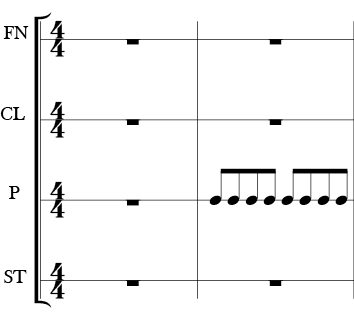
Body Percussion Examples
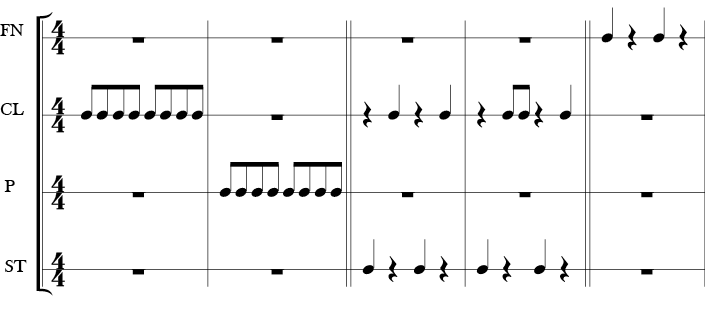
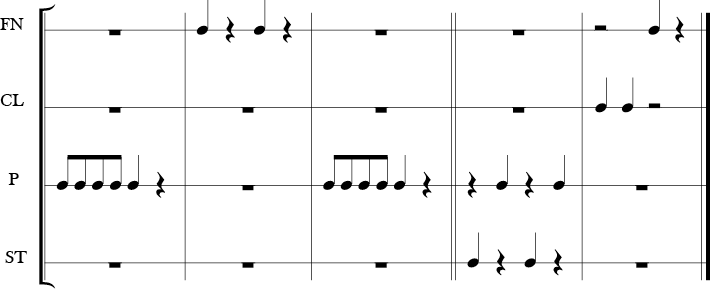
Simple Rhyme With Basic Body Percussion
One Two Three
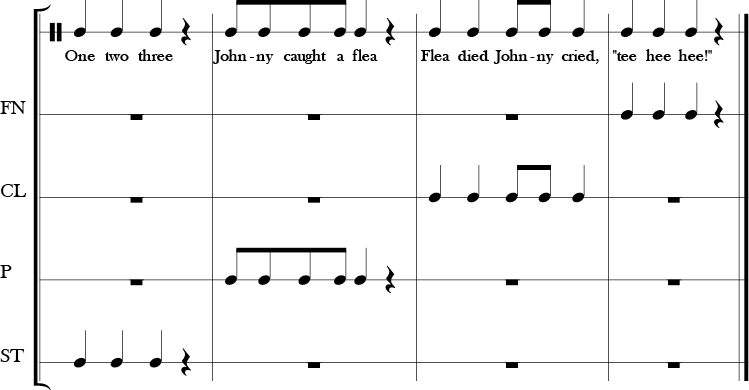
A good way to internalize the rhythm is to by first learning the rhyme, then adding the body percussion. After that, gradually drop the lyrics one measure at a time (either from the beginning to the end or from the end to the beginning) so that children end up only performing the body percussion, as the following example shows.
|
One two three One two three One two three One two three q q q |
Johnny caught a flea Johnny caught a flea Johnny caught a flea ee ee q ee ee q |
Flea died Johnny cried, Flea died Johnny cried, q q eeit q q q ee q q qit ee q |
“tee, hee, hee” q q q q q q q q q q q q |
Extension: Small groups can also perform this as a round with each group starting one measure apart.
Body percussion can become increasingly challenging as well. The next step would be to say (or sing) a rhyme along with an ostinato. The “One two three” rhyme, for example, uses all four maintypes of body percussion—stamping, clapping, patsching, and snapping—but not all of the types of body percussion need to be incorporated.
Jack and Jill
English nursery rhyme, 1760s
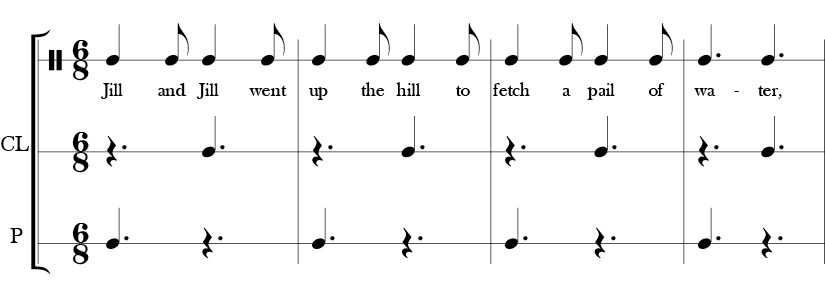
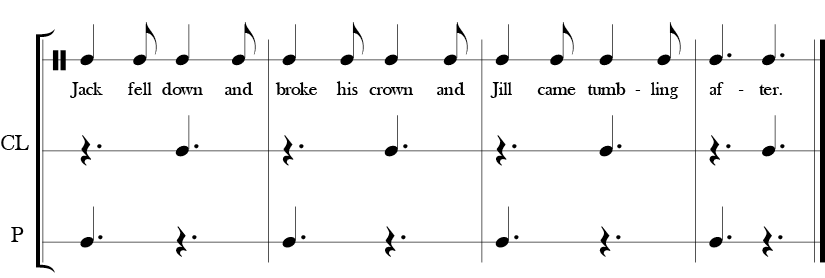
An even more challenging and creative way to use body percussion is to create onomatopoeia in accordance with the lyrics, mimicking or relating to the sounds presented in the rhyme. For example, in the rhyme “Banbury Cross,” the patsching eighth notes in measures 3 and 4 could be mimicking the hoofbeats of the horse. Also, the finger snaps in measure 5 indicate the rings-on-her-fingers line and likewise the stomps fit the bells-on-her-toes line. There is no right or wrong way to add body percussion to enhance the rhyme; it is all in the ear of the beholder!
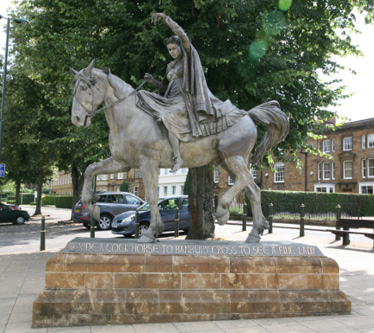
By Stratford490 [CC BY-SA 3.0 or GFDL], via Wikimedia Commons
The Fine Lady statue at Banbury Cross, Oxfordshire
Ride a Cock Horse to Banbury Cross
English Rhyme, 1780
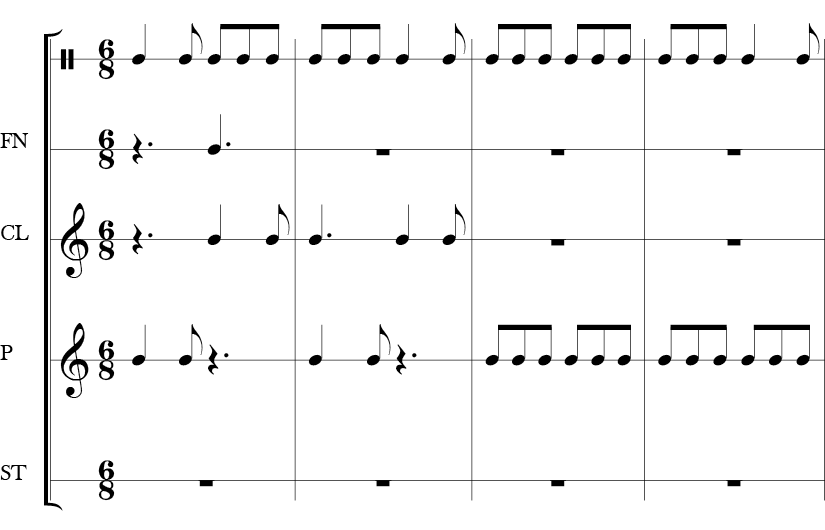
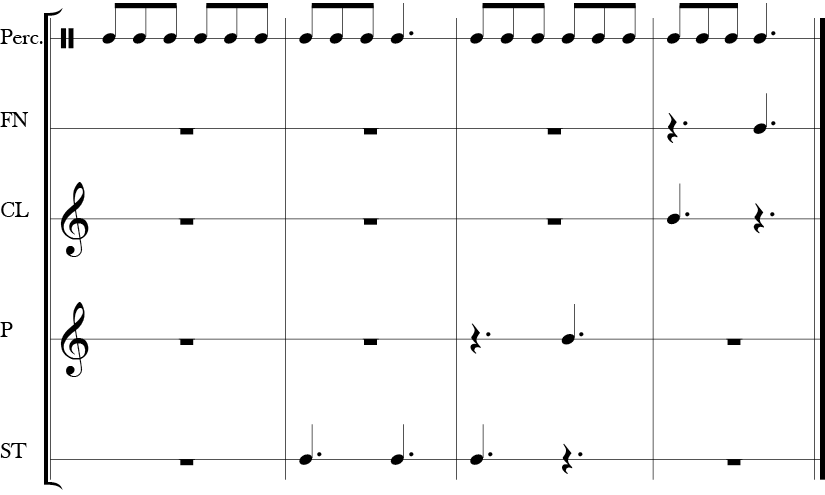
Activity 4A
Try this
Select a nursery rhyme. Say it a few times as rhythmically as possible. Then create a simple body percussion accompaniment such as patsch clap, patsch clap. Now try to vary the accompaniment to highlight or mimic the lyrics in some way.
Orff Improvisation
Schulwerk’s elemental music is based on both experimentation and improvisation, allowing children to explore the tones, rhythms, and timbres of music from their own abilities and creative perspectives. To this end, Orff created frameworks or pathways to help children experiment without pressure or stress.
The easiest way to experiment on the Orff instruments is to begin with the pentatonic scale, a scale with only five pitches. The pentatonic scale may be major or minor. For a major pentatonic scale, have children remove the F and B bars from their instrument leacing them with C, D, E, G, and A. This allows them to create beautiful music beginning and ending on C without having to worry about not sounding beautiful or making mistakes. For the minor pentatonic scale, keep the same five pitches, but begin and end on A.
Pentatonic Scales
Major Pentatonic (C Major)
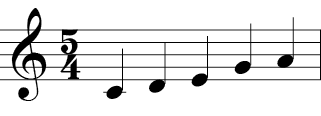
Major Pentatonic (F Major)
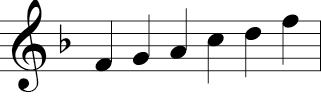
This is an example of F Major Pentatonic in the folk song “Great Big House.”
Great Big House


Minor Pentatonic (D minor)
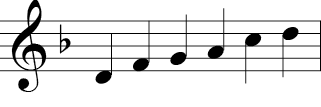
This is an example of D Minor Pentatonic in the folk song “The Canoe Song.”
The Canoe Song


Modes
Orff also made use of modes, which are types of scales with non-musical characteristics. The Greeks used modes such as Lydian (F to F on the white keys of a piano), Dorian (D to D on the white keys), Aeolian (A to A on the white keys or the natural minor scale), and Mixolydian (G to G on the white keys).
Lydian Mode

This is an example of Lydian mode in the “Simpson’s Theme Song” by Danny Elfman.
Simpson’s Theme Song (excerpt)

Dorian Mode

This is an example of Dorian mode in “Scarborough Fair,” an English folk song.
Scarborough Fair (excerpt)


Aeolian Mode (also known as the natural minor scale)

This is an example of Aeolian mode in the American folk song “Aeolian Lullaby.”
Aeolian Lullaby


Mixolydian Mode

This is an example of Mixolydian mode in “Norwegian Wood” by Lennon/McCartney.
Norwegian Wood (excerpt)

These modes are easily performed on the xylophone and beautiful and interesting in their construction. In particular, they can raise a child’s awareness of different moods and aesthetics, allowing them new modes through which to experiment with self-expression and also new material with which to enhance stories and narratives.
Activity 4B
Try this
The easiest way to experiment with modes is to begin and end on the pitches outlined above. Try experimenting with the Dorian D-to-D scale or Mixolydian G-to-G scale.
Speech and drama
Both Orff and Kodály techniques allow children to experiment with language to feel comfortable with their own internal speech and body rhythms. Creating poems or speech pieces and adding dynamics, musical instruments/timbres, playing with form (adding a musical introduction, bordun, etc.), and then acting them out enables a child’s creative process through language.
Adding music to drama
Taking a story and adding sound effects, leitmotifs, instruments, vocal sounds, body percussion, and actors and/or a narrator also brings literature to life. The goal of a leitmotif is to help the listener identify a main character or theme in the story. For example, characters and themes are given a short musical pattern, and every time that character or theme appears, the musical pattern is performed. Also, sound effects are added to enhance the action or bring a fuller meaning or experience. For example, if the story speaks of a bell chiming, play a bell peal on the glockenspiels for older children’s response, or more minimally, hit a triangle. Excellent stories for this type of activity include folk tales or fairy tales from around the world. (See Chapter 12 on Integration for an example).
Activity 4C
Try this
Use basic instruments to experiment with creating or changing the mood. For preschool and lower elementary students, use a small instrument such as a glockenspiel to play soft, slow music to set the mood for naptime or to quiet children down for a transition to a new activity. Perform an energetic rhythm on a drum to engage children to move or prepare for a more rigorous physical transition.
Quick play tip
The easiest way to make beautiful music on one of the Orff instruments is to remove the “F” and “B” bars and then play on the remaining notes. Anything you play will sound wonderful!
The Kodály Method
It is a long accepted truth that singing provides the best start to music education; moreover, children should learn to read music before they are provided with any instrument… Even the most talented artist can never overcome the disadvantages of an education without singing. (Kodály, 1974, p. 201, 204)
Kodály’s Philosophy
The Kodály philosophy of music education supports music’s role in the intellectual, emotional, physical, social, and spiritual development of every child. A central tenet of the Kodály approach is that music belongs to everyone—that an education in music is the right of every human being and cannot be left to chance.
Zoltán Kodály (1882–1967) was an ethnomusicologist and composer from Hungary. He was appalled by children’s poor singing quality, and began to create teaching methods to improve it. His approach was highly sequential. He began with sight-reading and mastering basic rhythms and pitches that gradually increased step by step to become more complex, sometimes by adding only one new note or rhythmic value at a time.
Kodály was also appalled at the type of songs and repertoire children were learning in school, and began to focus on utilizing authentic folk music and composed music of excellent quality through which to teach children.
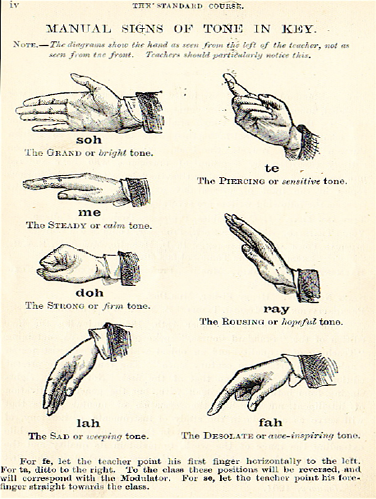
“Curwen Hand Signs” from The Standard Course of Lessons and Exercises by John Curwen. PD-US.
Depiction of Curwen’s Solfege hand signs. This version includes the tonal tendencies and interesting titles for each tone.
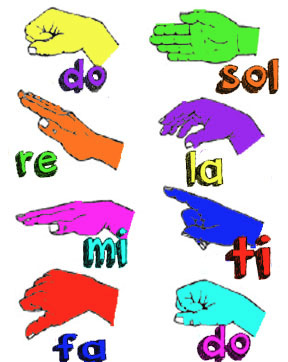
Figure 5. Kodály Hand signs adopted from Curwen
Kodály hand signs
Although he did not invent the hand signs, Kodály did make alterations based on two previously established hand sign systems—Sarah Glover’s Norwich sol-fa (1845) and John Curwen’s tonic sol-fa (1858). The hand signs are very much associated with the Kodály method, which uses the hand signs to help children visualize the spatial relationship between notes. This aids in proper and correct on-pitch singing as well as sight reading and ear training.
Positioning the hand signs
When using hand signs, the low Do should be placed at your waist or midsection, with the upper Do at about eye-level. The other hand signs are placed equidistantly between the two Do’s.
Solfege in Kodály
Although solfege singing was around long before Kodály, he became known for it as he used it extensively in his sight-singing system exercises and throughout his method. Solfege corresponds to the notes of the major scale, using the syllables Do, Re, Mi, Fa, Sol, La, and Ti. These words are often abbreviated to D, R, M, F, S, L, T, and D.

In terms of notation, Kodály’s exercises do not have to use the regular musical staff. Instead, exercises and even songs can be written out using just the D, R, and M, etc., with the rhythm notated about it.
For example, the song “Mary Had a Little Lamb” would look like this.
|
q q q q\\ M R D R |
q q q (r) M M M |
q q q (r) R R R |
q q q (r) M S S |
|
q q q q M R D R |
q q q q M M M M |
q q q q R R M R |
q (r) (r) (r) D |
Use of the solfege is a highly effective way to teach children that music or notes are separate entities from lyrics. Teaching a song using solfege rather than the lyrics helps the listener hear patterns and intervals, and even understand phrases and form that otherwise might be obscured by lyrics.
Solfege teaching sequence
Kodály singing technique begins with the child practicing only a few pitches and mastering them before moving on to another note; e.g., beginning with only a minor 3rd interval of Sol and Mi, and gradually adding the La after the Sol and Mi are mastered. Gradually, the child will expand the number of pitches learned to include the major pentatonic scale (Do, Re, Mi, Sol, La), and minor pentatonic scale (La, Do, Re, Mi, S).
Kodály Exercise Examples








After these are mastered, the student is introduced to all of the diatonic pitches (Do, Re, Mi, Fa, Sol, La, Ti, etc.) and then the accidentals.
Repertoire
Kodály was not only a composer and musicologist, but an early ethnomusicologist. He collected dozens of folk songs from his native Hungary and used them in his method. When using the Kodály method in the U.S., American folk songs are used.
Love Somebody
American folk song


On Top of Old Smoky
Appalachian courting song


The Kodály Song Web contains hundreds of American and other folk songs from around the world, as well as musical information on every song to help teachers learn and teach them.
Kodály rhythm syllables
Kodály also incorporates rhythmic syllables in his method. These syllables are based on the work of Emile-Joseph Chêvé, a French theoretician. These syllables are taught sequentially as well, and begin from basic note values (i.e., quarter notes) up to more complex combinations.
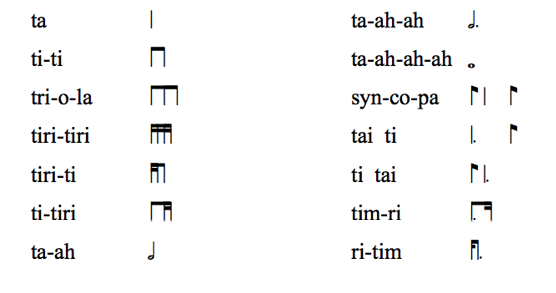
Kodály rhythm syllables
Movement in Kodály
Although he was mostly known for popularizing the solfege hand signs and rhythm syllables, Kodály recognized the value of bodily movement as well. He was inspired by Swiss educator Emile-Jacques Dalcroze’s use of movement (see below), and incorporated walking, running, and clapping into his teaching strategies.
read More Exploring Kodály: Philosophies, Materials and Pedagogy (Dr. Pattye Cesarow)
Edwin Gordon
Edwin Gordon developed his Music Learning Theory after years of music research and studies. Music Learning Theory explores how we learn when we’re learning music. Like many other researchers before him, Gordon realized we are lacking in terminology to explain all of the complex processes that go on with music learning and listening. Gordon’s main concept is called audiation, which he defines as “hearing and comprehending in one’s mind the sound of music that is not, or may never have been, physically present” (2007, p. 399).
Philosophy
According to Gordon, we are each born with music aptitude. As with other human learning potentials, there is a wide range of music aptitude levels distributed among the human population. Moreover, both music aptitude and music achievement are dependent on audiation; i.e., our music learning potentials and our music learning achievements are based on our music thinking. Most importantly, music thinking goes beyond mere imitation and leads to music comprehension (2007).
Gordon’s Skill Learning Sequence is based on two main categories of learning: Discrimination and Inference. Discrimination learning occurs by rote, and occurs when a teacher teaches the basic building blocks of music—vocabulary and aural and rhythmic patterns. Inference learning occurs conceptually, where the student is able to identify, create, and improvise with musical materials already learned. The student at this point is discovering music on his or her own.
Rhythmic learning concerns understanding three basic concepts: the macrobeat, the microbeat, and melodic rhythm. Macrobeats are those we feel as main beats or longer beats such as when we’re dancing. In 4/4 or 2/4 time, for example, the macrobeat is represented by quarter notes, while in 3/4 time it is represented by the dotted half.
Examples of Macrobeats

Microbeats are shorter than macrobeats and represent the equal division of the macrobeat. In 4/4 or 2/4 time, microbeats would be represented by the eighth notes, while in 3/4 time microbeats would be represented by the quarter notes.
Examples of Microbeats

Melodic rhythm refers to any rhythmic patterns in a piece. Rhythms can relate to the melody or text from a piece of music. Similar to Kodály, Gordon also used two types of solfege—tonal solfege (do, re, mi, etc.) for the pitches and rhythm solfege for rhythm (du de, du de, etc. to represent duple meter, and du da di, du da di to represent triple).

His approach begins on a holistic level, where the student experiences the whole song, piece, and so forth; applies analysis; and then re-experiences the whole again but now through the lens of having analyzed the inner workings in detail.
Similar to other sequenced learning approaches, such as Vygotsky’s Zone of Proximal Development or scaffolding, Gordon’s approach relies on a gradual increase in skill level difficulty as the student progresses. For example, because improvising music is far more complex than imitating basic patterns, the latter is required in order to perform the former. This “Whole-Part-Whole” process recommends first engaging in generalized activities to “experience the whole,” then progressing to “Study the parts,” finally returning again to the entire piece of music (Valerio, n.d.)
read more The Gordon Approach
Dalcroze
Emile-Jacques Dalcroze is a Swiss educator best known for eurhythmics, which incorporates rhythm, structure, and musical expression with movement. The ultimate goal is to develop total cognitive and kinesthetic awareness through sound. The music acts as a stimulus to which the body responds, after which sensation returns to the brain to form emotions, which deepens the significance of the experience.
Philosophy
The Dalcroze philosophy centers on the concept that the synthesis of the mind, body, and resulting emotions is fundamental to all meaningful learning. Plato said in his Laws: “Education has two branches, one of gymnastics, which is concerned with the body, and the other of music, which is designed for the improvement of the soul” (Pennington, 1925, p. 9). Emile-Jaques Dalcroze believed that every musician should strive to be sensitive and expressive, and to express music through purposeful movement, sound, thought, feeling, and creativity.
Mead (1994) cites four basic premises that encapsulate the Dalcroze philosophy:
- Eurhythmics awakens the physical, aural, and visual images of music in the mind.
- Solfege (sight singing and ear training), improvisation, and eurhythmics together work to improve expressive musicality and enhance intellectual understanding.
- Music may be experienced through speech, gesture, and movement.
- These can likewise be experienced in time, space, and energy. Humans learn best when learning through multiple senses. Music should be taught through the tactile, kinesthetic, aural, and visual senses.
The Dalcroze approach is based on eurhythmics, which teaches rhythm, structure, and musical expression through music. Eurhythmics begins with ear training, or solfege, to develop the inner musical ear. This differs from Kodály’s use of solfege in that it is always combined with movement. Another component of the method concerns improvisation, which helps students sharpen their spontaneous reactions and physical responses to music.
Types of movement
Each movement involves time, space, and force, and all three should be taken into account when moving, paying close attention to the musical attributes of the movement.Time: Tempo (rate of speed) and duration (fast, moderate, slow)
- Space: Direction, distance covered, level, dimension (large, small), path (straight, twisted), and focus
- Force: Energy or power expended, quality of the movement, and any adjectives to describe the movement (e.g., heavy, light, sharp, energetic, gentle)
Movement that stays stationary is called non-locomotor, while movement that moves through space is locomotor.
- Non-locomotor (movement in place):
- Stretch, curl, clap, snap, patsch, tap, stomp, twist, turn, conduct, sway, jump, bend, speak, stretch, swing, reach
- Locomotor (movement through space):
- Walk, slide, skip, run, leap, gallop, hop, jump, slither, creep, roll, jog
Regardless of the type, movements should above all be musical. Movements should also be focused and thoughtful; i.e. preparation should occur before each movement; the movement should take into account the full length of the beat; and the movement should return back to pre-preparation status. It is essential that the movement coordinate with the beat of the music, the rhythm, and the phrasing (depending on the exercise).
Dalcroze’s exercises are always sequential, beginning with the simplest and becoming more complex as students master and develop their skills. Children are introduced to key musical elements such as meter, dynamics, rhythms, tempo, duration, melody, form, phrase, and pitch.
Types of eurhythmics
There are four types of basic eurhythmic exercises:
- Follow
- Quick reaction
- Interrupted canon
- Canon
- A follow exercise is a basic music-movement response exercise. Students physically respond to the sounds they hear.
Examples:
Students walk to the beat of music (piano, drum, etc.) and respond to changes of tempo (speeding up or slowing down), rhythms (walking on quarter notes, running on eighth notes, skipping on dotted rhythms), etc.
- A quick reaction exercise requires students to respond to verbal signals or cues.
Examples:
Students move while the music is playing and freeze when the music stops or the teacher yells out a command. Students also can change their movements on a given signal, such as switching from a loco-motor to a non-loco-motor when they hear a drum beat or chime or when the music stops.
- An interrupted canon is similar to an “echo” where students imitate or echo a beat, pattern, etc. The interrupted canon is a preparatory exercise for the canon.
Examples:
Students hear a rhythm and then echo it back on their body (lap, clap, etc.).
- A canon requires students to echo back a pattern, but one measure later. While they are performing their pattern, they are simultaneously listening and memorizing the new pattern.
Examples:
The teacher claps patterns. Students respond one measure later while continually absorbing the pattern currently being performed. Pass the pattern: A more challenging version of this is to have students form two straight lines. The teacher stands in front and “passes” a pattern to the first student in one of the lines. That student then “passes” it to their partner across the aisle, who then passes it across the aisle, etc. All the while, new patterns are being formed and passed.
Dalcroze movement requires that children listen and respond simultaneously. The music mirrors the physical motions expected. For example, music for walking or marching is in duple meter and uses steady quarter notes, running music contains eighth notes, skipping music uses dotted rhythms, jumping music contains large interval leaps, and so forth.
Reggio Emilia
Although not an approach to music teaching in and of itself, this popular educational method is worth exploring in its relation to music education. The basic approach utilizes discovery in terms of music learning, and also is synchronous with many of the 21st-century learning approaches discussed in Chapter 1.
- The child as the creator of his/her own learning
- The child and adult as researchers
- The environment as the third teacher
- Documentation as communication
- The 100 expressive languages of children
- The dialogue between child and adult
- Collaborative work (Smith, 2011)
Suzuki
I want to make good citizens. If a child hears fine music from the day of his birth and learns to play it himself, he develops sensitivity, discipline and endurance. He gets a beautiful heart.
—Shin’ichi Suzuki
More than 50 years ago, Japanese violinist Shin’ichi Suzuki realized the musical implication of the fact that all children learn to speak their native language with ease. He began to apply the basic principles of language acquisition to music learning, and called his method the mother-tongue approach.
Suzuki understood that making good musicians requires investment in developing the whole child - from their morality to their character and ability to be good citizens. Only in this larger context can the child focus on developing their musical ability. The ideas of parent responsibility, loving encouragement, constant repetition, etc., are some of the special features of the Suzuki approach.
When a child learns language, they undergo a very extensive form of enculturation. They begin by listening and repeating, mastering the linguistic process step-by-step. They have to then memorize, build vocabulary, and are motivated by environmental, cultural and social factors, including that of love. To learn music using the Suzuki approach, the child must replicate the steps of language learning by listening to excellent recordings so that beautiful music becomes part of their natural environment. Recordings also provide inspiration, and lay the groundwork for understanding music’s vocabulary and structure. Parental involvement is also key to the student’s success, and parents provide daily motivation, encouragement, and support. Parents often learn the instrument along with the child, acting as musical role models, and maintaining a positive learning atmosphere for the child to succeed.
Resources
Organization of American Kodály Educators https://oake.org/default.aspx
The Dalcroze Society of America http://www.dalcrozeusa.org/
The Gordon Institute for Music Learning http://giml.org/
The American Orff-Schulwerk Association http://www.aosa.org/
The Suzuki Association of the Americas http://suzukiassociation.org/teachers/twinkler/
Alliance for Active Music Making http://www.allianceamm.org/
References
Orff
Campbell, P. S. (2008). Musician and teacher. New York: W.W. Norton and Company.
Goodkin, D. (2004). Play, sing and dance: an introduction to Orff Schulwerk. New York: Schott Music Publishers.
Gray, E. (1995). Orff-Schulwerk: Where did it come from? The Orff Beat-Centenary Issue XXIV (June 1995). Victorian Orff Schulwerk Association. 03 May 2009 www.vosa.org/aboutorff/?pageID=14
Orff, C. (1963). “Orff Schulwerk: Past and Future.” Speech. Opening of the Orff Institute in Salzburg, October 25. Trans. Margaret Murray.
Orff, C., & Keetman, G. (1976). Music for children (Vols. 1-5) (M. Murray, Trans. ). London: Schott & Co. (Original work published 1950-1954).
Shamrock, M. (1997). “Orff-Schulwerk: An integrated method. Music Educator’s Journal, 83, 41–44.
Dalcroze
Abramson, R. M. (1980). Dalcroze-based improvisation. Music Educators Journal, 66(5), 62–68.
Anderson, W. T. (2012). The Dalcroze approach to music education: Theory and Application. General Music Today, 26(1), 27–33.
Aronoff, F. W. (1983). Dalcroze strategies for music learning in the classroom. International Journal of Music Education, 2, 23–25.
Bachmann, M. L. (1991). Dalcroze today: An education through and into music (D. Parlett, Trans.). New York: Oxford University Press.
Boyarsky, T. L. (1989). Dalcroze eurhythmics: An approach to early training of the nervous system. Seminars in Neurology, 9, 105–114.
Bugos, K. M. (2011). New York State early-career teachers’ selection and use of pedagogical approaches in elementary general music. Ph.D. dissertation, University of New York at Buffalo, New York. Dissertation & Theses: 3475296.
Caldwell, T. (1992). Dalcroze eurhythmics [videorecording]. Chicago: GIA Publications.
Dale, M. (2000). Eurhythmics for young children: Six lessons for fall. Ellicott City, MD: MusiKinesis.
Driver, E. (1951). A pathway to Dalcroze eurhythmics. London: T. Nelson and Sons.
Findlay, E. (1971). Rhythm and movement: Applications of Dalcroze eurhythmics. Secaucus, NJ: Summy Birchard.
Jaques-Dalcroze, E. (1920). The Jaques-Dalcroze method of eurhythmics: Rhythmic movement (Vols. 1 & 2). London: Novello.
Leck, H., & Frego, R. J. D. (2005). Creating artistry through movements. (DVD). Milwaukee, WI: Hal Lenard. #08744511. ISBN: 0634098381.
Mead, V. H. (1994). Dalcroze eurhythmics in today’s music classroom. New York: Schott Music Corporation.
Pennington, J. (1925). The importance of being rhythmic. New York: Knickerbocker Press.
Zachopoulou, E., Drri, V., Chatzopoulou, D., & Elinoudis, T. (2003). The application of Orff and Dalcroze activities in preschool children: Do they affect the level of rhythmic ability? Physical Educator, 60(2), 51–58.
Kodály
Choksy, L. (1981). The Kodály context: Creating an environment for musical learning. Englewood Cliffs, NJ: Prentice-Hall.
Choksy, L. (1999). The Kodály method I: Comprehensive music education. Upper Saddle River, NJ: Prentice-Hall.
Kodály, Z. (1965). Let us sing correctly. London: Boosey & Hawkes.
Kodály, Z. (1974). The selected writings of Zoltán Kodály. (Lily Halápy and Fred Macnicol, Trans.). London: Boosey & Hawkes.
Kodály, Z. (1965). 333 elementary exercises. London: Boosey & Hawkes.
Kodály song web. (n.d.). Retrieved from http://www.kodalysongweb.net/songs
Shehan, P. K. (1986). Major approaches to music education: An account of method. Music Educator’s Journal, February 72(6), 26–31.
Trinka, J. (n.d.). The Kodály approach. Retrieved from http://www.allianceamm.org/resources/dalcroze/
Gordon
Gordon, E. E. (2007). Learning sequences in music: A contemporary music learning theory. Chicago, IL: GIA.
Valerio, W. (n.d.). “The Gordon approach: Music learning theory.” The Alliance for Active Music Making. Retrieved from http://www.allianceamm.org/resources/gordon/.
Suzuki
Scott, L. (1992). Attention and perseverance behaviors of preschool children enrolled in Suzuki violin lessons and other activities. Journal of Research in Music Education, 40, 225–235.
Suzuki, S. (1993). Nurtured by love: The classic approach to talent education. 2nd ed. New York: Alfred Music.
Suzuki, S., & Nagata, M. (1999). Ability development from age zero. NY: Alfred Music.
Reggio Emilia
Crisp, B. ,& Caldwell, L. (2007). Orff-Schulwerk and the Reggio approaches are interwoven successfully. The Orff Echo, 39(3), 26–30.
Edwards, C., Gandini, L., & Forman, G. (1998). Introduction: Background and starting points. In The hundred languages of children: The Reggio Emilia approach—Advanced reflections (5–26) (2nd ed.). Greenwich, CT: Ablex Publishing.
Smith, A. P. (2011). The incorporation of principles of the Reggio Emilia approach in a North American pre-school music curriculum: An action research. Visions of Research in Music Education, 17 .
General Reference
Chosky, L., Abramson, R., Gillespie, A., Woods, D., & York, F. (2000). Teaching music in the twenty-first century (2nd ed.). Upper Saddle River, NJ: Pearson.
Alliance for Active Music Making. (n.d.). Retrieved from www.allianceamm.org/resources_elem_Orff.html
Moore, J. (n.d.). Philosophy of the Alliance for Active Music Making. Retrieved from http://www.allianceamm.org/philosophy/
Vocabulary
canon (Dalcroze): a eurhythmic exercise in which students echo back a pattern, but one measure later, and while they are performing their pattern, they are simultaneously listening and memorizing a new pattern
Curwen hand signs: hand symbols developed to represent the notes of the scale; i.e., do, re, mi, fa, sol, la, ti, do
drone: a continuous low tone produced by the bass pipes or bass strings of musical instruments
elemental music (Orff): is pattern-based music built on natural speech and body rhythms, familiar melodic patterns, and simple forms that can be readily understood and performed by children without extensive musical training
eurhythmics (Dalcroze): a method of instruction developed by Dalcroze to introduce rhythm, structure, and musical expression through movement; the ultimate goal of the method is to develop total cognitive and kinesthetic awareness through sound
follow (Dalcroze): a basic eurhythmics exercise in which the students physically respond to the sounds they hear
force: strength, energy, power, intensity
instrumentarium (Orff): instruments used to play Orff music
interrupted canon (Dalcroze): a eurhythmic exercise in which students imitate or echo a beat or pattern; a preparatory exercise for the canon
locomotor: movement through space
metallophone: any musical instrument consisting of a graduated series of metal parts that can be struck by hammers operated manually or played with a keyboard
mother-tongue approach (Suzuki): children are influenced by their surroundings with fine music
movement: moving the body to go with the rhythm or sound of the music
non-locomotor: movement in place
ostinato: a constantly recurring melodic fragment
quick reaction (Dalcroze): a eurhythmic exercise in which students react to verbal signs or cues
rhythm syllables: rhythm representations developed by Kodály
solfege: a syllable system used for sight singing; each note of the scale is represented by a syllable: do, re, mi, fa, sol, la, ti, do
space: the portion or extent of this in a given instance; the designed and structured surface of a picture
time: a limited period or interval, as between two successive events
xylophone: a musical instrument consisting of a graduated series of wooden bars usually sounded by striking with small wooden hammers






